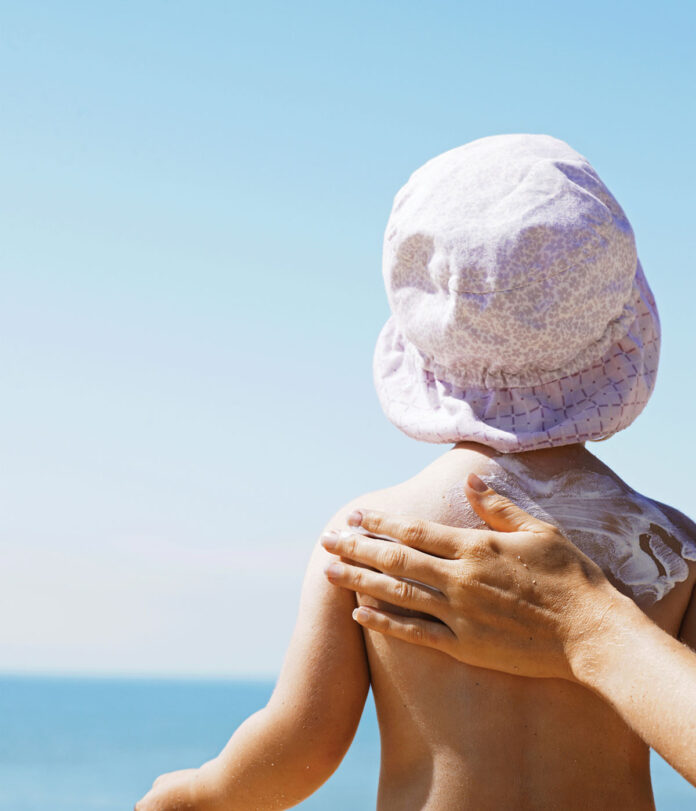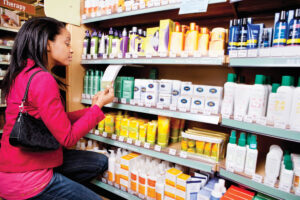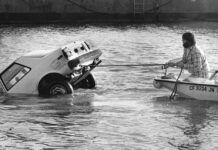
Twenty percent of American will get skin cancer in their lifetime. That’s one out of five Americans.
Fifty percent of Caucasians by the age of 50 will develop skin cancer, said Sharp Community Medical Group dermatologist Dr. Mona Mofid, who added that for the most part it comes from a lifetime of accumulated sun exposure.
“All those deposits that you put in the bank over the years accumulate, sometimes with interest,” she said. “People sometimes equate sunshine or heat with ultraviolet light, but the reality is anybody who has been skiing or out on a boat knows that ultraviolet light is there all the time. Some of the worst sunburns people will get will be on a cloudy day or overcast day. That ultraviolet light is still there. So, it is really more light opposed to the sun.”
Mofid said living in Southern California there is sun most of the time and though she wants people to get out and enjoy the outdoors, but that they should be smart about it. Hence, the need for sun protection. She advises people to wear longer sleeves, clothing specifically designed to block UV rays, so they do not always have to wear sunscreen. But she said sunscreen is an important part of keeping your skin healthy and avoiding skin cancer.

“People ask me if they should put on sunscreen on before they go outside, and it is a good idea just so you do not forget to use it,” she said. “People go out and get distracted and they forget to cover certain areas. And if you are wearing longer sleeves, pants, and hats, you should not have to worry about it.”
Mofid said it is important to remember it is the accumulative exposure to UV rays, and that one person dies every hour from skin cancer in the country.
She said melanoma is the most dangerous form of skin cancer, but basal cell carcinoma and squamous cell carcinoma all are directly connected to UV light exposure, adding that squamous cell can also be deadly if it spreads to other parts of the body, such as lymph nodes.
Mofid said skin cancer affects all ages, with her youngest patient being 4 years old, so everyone is at risk.
“Now we are seeing many more people aware of skin cancer, so you see kids out playing wearing long sleeves, hats. Now it is cool to wear a rash guard and they are easily affordable,” she said.
She said one of the top questions she is asked is what sunscreens are best to use.
“We favor metal-based sunscreens which are titanium and zinc based because those reflect the light back, they are organic, they are safe for the ocean and the coral reefs,” she said. “About 40,000 tons of sunscreen winds up in the ocean every year. That is why certain areas like Hawaii have banned what we call chemical sunscreens because so much sunscreen winds up in the ocean it has shown to be toxic to coral, where zinc or titanium is just dirt and reflects the light. Those are the types that give you that white sheen, but now they have micronized them or tinted them, so they are friendlier. Chemical sunscreens are still safe for humans, so if you have them, use them up but gravitate towards metal-based sunscreens because they are better for the environment.”
Mofid said with sunscreen, there is a flavor for sunscreen, especially when it is for use on the face. She said looking for a lotion with sunscreen in it rather than sunscreen, most people will find a product that they like. She said Neutrogena hydro boost works well for men. If your skin is oily, she said to look for a gel-based sunscreen as they are alcohol-based and not greasy. If your skin is dry, you want something that has more lotion in it.
“They make sunscreens in powders, gels, sprays, so sometimes it is finding the best one that works for you and sticking with it,” she said. “Even an Oil of Olay with sunscreen in it, and remembering your ears and neck is helpful.”
Mofid said unlike other regions, people are outdoors more often in Southern California.
“Seeking shade is so important,” she said. “We helped donate two of the shade shelters at Santee Lakes along with the Melanoma Foundation. For the playground that has handicapped access they had lost a large tree that provided shade, so they reached out to us, and along with the Melanoma Foundation, the Santee Santas, the rotary club, we provided a shade structure. The Melanoma Foundation just provided a grant for another shade structure.”
Mofid said many people have wised up and reminds people that skin is the largest organ of the body.
“When you talk about skin cancer affecting 20% of Americans, that is someone in your family,” she said. “When people say I have dark skin, Bob Marley died of skin cancer. Most people do not realize that. He died of melanoma on his toe.”
“People are always out on the water, they are barefoot, or surfers, and they forget about looking at their feet. I have had two patients this year where I found melanoma on their feet and they were not aware of them,” she continued.
Mofid said another large problem is people still using tanning salons.
“Tanning salons use UV light that is 100 more times powerful than the sun and it penetrates deep down,” she said. “One single tanning salon session increases your risk of skin cancer by 75%. It penetrates so deep down into the skin. That is why we see one of the largest demographics for melanoma are women ages 20 to 29 because they use tanning salons. Spray tans are totally safe, tanning salons are absolute death traps. It is like exposing your body to a nuclear reactor. Even once can be extremely dangerous.”
Mofid said in the conversations about lotions versus sprays, she personally likes the sprays for adding sunscreen. Her number one preference is clothing.
“I am happy if you use what you like,” she said. “If you like the sprays that is great, lotions are great because you can spread them out. Just use something.”
She said people complain about how sunscreens feel, smell, but sunscreen is a billion-dollar industry and people can find something they like if they look for it.
Mofid said in America there is more skin cancer of the left side of the face, in Europe more on the right side of the face, because that is the driver’s side.
“People often forget they get so much UV light when driving,” she said, adding that you can see sun damage by wrinkles on the face. “If skin cancer doesn’t scare you, having your skin looking like leather should. Leather is hide, skin that is tanned. People who I cannot convince to wear sunscreen because of skin cancer, usually I can convince them when I show them pictures of these horrible wrinkly skin. The skin ages from UV light. I recommend using a moisturizer with sunscreen and leaving it in your car. That way when you are at that long stoplight, you can take the opportunity to put in on. We age people psychologically based on their eyes, their lips, and their hands.”
Mofid said UV light also causes cataracts, so she recommends nice sunglasses that wrap around to help prevent cataracts as well.
Mofid said still, lifetime exposure is the biggest culprit in getting too much UV light, even if you feel like you are not outside that much.
“You sit by a large window that lets in UV light. You go outside to the mail box, walking the dog. Those 5, 10, 15 minutes all add up to UV light exposure. We have done studies with people who said they did not get much UV light in a day, and we put a little meter on them, and they have hours of UV light exposure. Again, it is those 10, 15 minutes, talking to a neighbor, walking a dog, getting the mail. It is just like calories. If you are snacking and getting those calories, it is like UV light, it is all cumulative. Brush your teeth in the morning, put on sun protection on your face, ears, and hands daily. Then you really do not have to think about it so much.”














